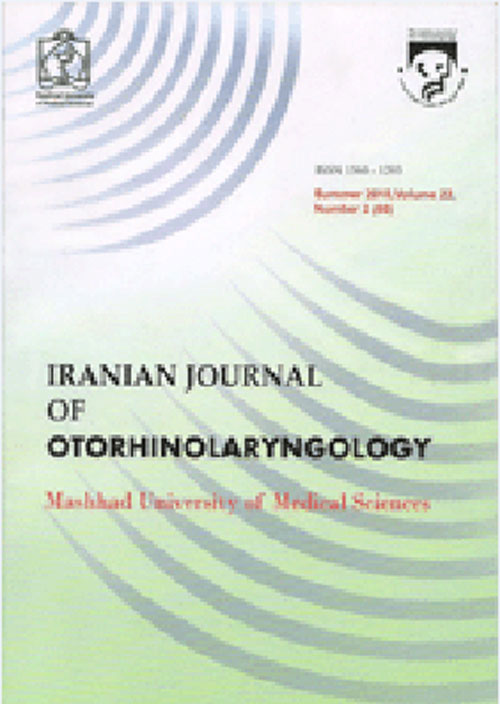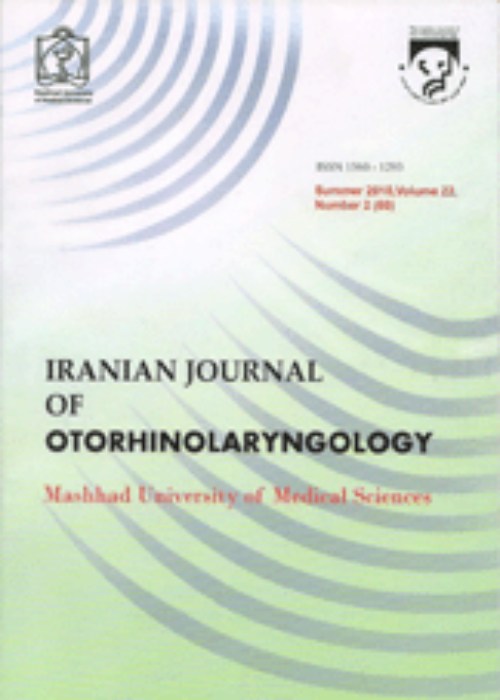فهرست مطالب

Iranian Journal of Otorhinolaryngology
Volume:33 Issue: 6, Nov-Dec 2021
- تاریخ انتشار: 1400/08/13
- تعداد عناوین: 10
-
-
Pages 339-346Introduction
Benign paroxysmal positional vertigo (BPPV) is a common cause of peripheral vestibular disturbances. Particle repositioning or liberatory maneuvers provide relief of symptoms in the majority of patients. However, studies mainly focus on success. This study aims to review the conditions that may have an impact on residual dizziness or recurrence following therapeutic maneuvers in patients with BPPV.
Materials and MethodsA review of the literature about the analysis of quality of life after therapeutic maneuvers was conducted. Three hundred and seven articles after search in the PubMed database were classified into eight main groups after exclusion of those that are not suitable to predetermined criteria.
ResultsThirty-eight articles for residual dizziness in BPPV, eighty-three articles for the duration of BPPV, forty articles for the type of canal involvement, forty-three articles for the impact of age, one hundred and nine articles for the gender difference, forty-seven articles for co-morbid conditions, one hundred and twenty-four articles for medication and sixty-eight articles for vestibular exercises in BPPV were selected.
ConclusionVEMP abnormality is a reliable indicator to demonstrate the risk of recurrence. Duration of dizziness has no significant impact on recurrence. But the length of duration is important for residual dizziness. Vestibular rehabilitation or medication alone has no place in treatment but may help to reduce the symptoms in addition to maneuver. Self-perceived evaluation of balance after therapeutic maneuvers is recommended for the selection of those who need rehabilitation or additional medication.
Keywords: Benign paroxysmal positional vertigo, Balance, Quality of life, Residual dizziness, Recurrence -
Pages 347-353IntroductionLarge anterior palatal fistula and special alveolar clefts, such as edentulous atrophic premaxilla and absent premaxilla (premaxillectomy or agenesis), as well as wide unilateral alveolar cleft, are complicated cases in alveolar cleft bone grafting surgery. A superiorly-based buccinator myomucosal flap is suitable in this regard.Materials and MethodsThe cleft patients whose large anterior palatal fistula and superiorly based buccinator myomucosal flap had been used for palatal or alveolar reconstruction were recruited in the study. The reconstruction method of the nasal floor, follow-up time, and hospital length of stay were recorded.ResultsA total of 10 patients had been treated by this method. The majority of them were male (6/10), the age range of the patients was 14-25 years. All flaps survived and a case of partial necrosis occurred.ConclusionAs evidenced by the obtained results, a superiorly-based facial artery musculomucosal flap is suitable when the palatal fistula is continuous with the alveolar cleft. Transmaxillary transfer is the other option in patients with closed maxillary arch.Keywords: Buccinator flap, Cleft palate, Palatal fistula
-
Pages 355-359IntroductionThe present study aimed to compare the effects of paracetamol and ibuprofen on pain, bleeding, nausea, and vomiting following adenotonsillectomy in children.Materials and MethodsThis was a prospective, double-blinded, randomized clinical trial. Block randomization was used to assign 50 patients to two groups of paracetamol and ibuprofen. In the paracetamol group, subjects received 15 mg/kg oral paracetamol 30 min before the induction of anesthesia, followed by the same dosage every 6 h postoperatively. Meanwhile, the ibuprofen-treated group took 10 mg/kg oral ibuprofen 30 min before and every 6 h after the operation. The subjects in both groups received the medication for three postoperative days. The postoperative pain score was assessed 6 h after the surgery and during the second and the third postoperative days. Nausea and vomiting episodes were recorded in the first postoperative day and first postoperative week.ResultsBased on the results, intraoperative and postoperative bleeding in both groups was not significantly different. The mean score of pain in the first postoperative day (6 h after the surgery) and the second and the third postoperative days did not show any statistical difference. The ibuprofen group experienced fewer vomiting episodes, compared to the paracetamol group during the first postoperative day (P=0.011). Vomiting episodes in the first postoperative week did not illustrate any significant difference.ConclusionAs evidenced by the results of the current study, Ibuprofen had the same effect on the alleviation of postoperative pain, caused fewer vomiting episodes, and did not cause excessive bleeding as an NSAID. Therefore, Therefore, oral administration of ibuprofen is suggested for pain relief and management of other complications following adenotonsillectomy in children.Keywords: Adenotonsillectomy, Paracetamol, Ibuprofen
-
Pages 361-367IntroductionTranspterygoid approach is an expanded endonasal approach (EEA) that allows surgical access to the medial infratemporal fossa, to the skull base area of petrous bone and to the Meckel’s cave. During this approach, a sacrifice of sphenopalatine artery is often required, leading to the need of contralateral Hadad-Bassagasteguy flap (HBF) or alternative reconstructive techniques.Materials and MethodsWe report a case of spontaneous CSF leak due to a meningo-encephalocele in the left lateral recess of sphenoid sinus, in which an ispilateral nasoseptal flap was harvest and sphenopalatine artery was preserved.ResultsWe described the surgical technique adopted to preserve the ipsilateral nasoseptal vascular pedicle during transpterygoid approach and we performed a review of the pertinent literature.ConclusionWide exposure of the pterygoid base through transpterygoid approach could be obtained preserving the sphenopalatine artery, allowing skull base reconstruction with ipsilateral nasoseptal flap.Keywords: Endoscopy, Endonasal, Ipsilateral, Nasoseptal, Reconstruction, Skull base, Transpterygoid
-
Pages 369-373IntroductionNasal packing is a common procedure used to ensure haemostasis after nasal surgery.Materials and MethodsA prospective, randomized, controlled and double-blinded study was conducted on 80 consecutive subjects to investigate whether using Nasal Dressing Sponge® (NDS) instead of simple Merocel® might improve patients’ postoperative experience of nasal packing.ResultsDuring the stay of the tampons no differences were noticed between the two groups as regards the postoperative pain. When it comes to pain during the packing removal, patients complained of worse symptoms in the side packed with Merocel. There was no bleeding after the removal of Merocel, whereas 5,6% patients were subject to some bleeding when NDS was removed.ConclusionMerocel and NDS gave similar results regarding haemostatic activity. Nasal Dressing Sponge could decrease pain during the removal of the nasal pack, while it could be associated to a bigger incidence of mild bleeding after removing the pack.Keywords: Merocel, Nasal pack, Epistaxis, Pain, Septoplasty
-
Pages 375-381IntroductionRational surgical antibiotic prophylaxis is suggested for some selected surgical processes. However, inappropriate utilization of antimicrobial prophylaxis reduces benefits and increases costs and risks, such as antibiotic resistance. This study aimed to evaluate the current practice of antibiotics prescribed by surgeons in common otologic surgeries.Materials and MethodsThis cross-sectional study was conducted among otolaryngologists with at least 5 years of experience in common otologic surgeries (tympanoplasty, tympanomastoidectomy, stapes, or middle ear exploration (MEE) surgeries). A total of 257 otolaryngologists filled a checklist about their selected regimen and timing of antibiotic(s) administration.ResultsThe rates of antibiotic prophylaxis prescription in dry and wet ears in tympanoplasty were 7.4% and 87.1% (preoperative), 40.9% and 47% (intraoperative), 88.3% and 98% (postoperative); in tympanomastoidectomy with no cholesteatoma were 7.1% and 97.8% (preoperative), 39.6% and 50.9% (intraoperative), 93.7% and 99.6% (postoperative); in tympanomastoidectomy with cholesteatoma were 14% and 98.3% (preoperative), 45.4% and 51.9% (intraoperative), 98.3% and 99.6% (postoperative), respectively, and in stapes or MEE surgeries were 6.4% (preoperative), 41.7% (intraoperative) and 73.1% (postoperative), respectively. There were no significant differences in the rates of prescribing intraoperative prophylaxis between wet and dry ears, except in tympanomastoidectomy without cholesteatoma. Overall, the most prescribed antibiotics were cephazolin, cephlexin, and ciprofloxacin drop.ConclusionThe results of this study revealed the inappropriate administration and timing of antibiotic prophylaxis regarding current literature evidence. Despite the lack of evidence on the potential role of antibiotic prophylaxis in clean-contaminated and contaminated ears, a significant number of surgeons prescribed prophylactic antibiotics in tympanoplasty and tympanomastoidectomy without cholesteatoma.Keywords: Antibiotics, Ear surgeries, Otologic surgeries, prophylaxis
-
Pages 383-387Introduction
Laryngeal web is a rare cause of pediatric stridor and respiratory distress. The clinical presentation is variable and symptoms usually correlate with the severity of the airway obstruction.
Case Reports:
We describe the cases of three children unexpectedly diagnosed with laryngeal web after a severe episode of bronchiolitis and after thirteen and eleven years, respectively, of persistent symptoms despite asthma medications.
ConclusionEven if it is a rare cause of stridor and respiratory distress, congenital subglottic web could be a life threatening condition and clinicians should always consider it in the differential diagnosis of persistent noisy breathing, even in adolescents and young adults.
Keywords: Airway, Stenosis, reconstruction, Larynx, Pediatric airway -
Pages 389-394Introduction
Chondrosarcomas (CS) are malignant mesenchymal tumours with cartilaginous differentiation that rarely affects the maxillofacial region. It accounts for approximately 10-20% of malignant bone tumours. The CS is rare in occurrence with aggressive course with high malignant potential, and poor prognosis.
Case Report:
Here we report a rare case of a 37year old female presenting tumoral mass in the lower jaw, for the past 3 years, which was gradually progressive in nature with an area of skin ulceration. The CT revealed a well- defined lesion with soft tissue component measuring 15x12x10 cm in size infiltrating both right and left masseter. Biopsy confirmed the diagnosis of grade IIICS. Considering the size and aggressive nature of the lesion, surgical resection was done. The reconstruction of the mandible was done with vascularised fibula pedicle flap to achieve acceptable cosmesis. The patient was discharged uneventfully. Though few cases of high grade CS have been reported in literature but CS of this enormous size has not been reported yet.
ConclusionIn this case report we documented the management of a relatively rare but challenging reconstructive maxillofacial surgery. Since in this case the CS was enormous in size and aggressive surgery was required, the cosmetic and functional outcomes were challenging. In our case report we have found that a vascularised fibula pedicle flap gives a good functional and cosmetic outcome and can be used for reconstruction of complete mandible.
Keywords: Chondrosarcoma, Malignant, Mesenchymal, Neoplasm, Mandible -
Pages 395-398Introduction
Concha bullosa is a usual anatomical variation of the nose and paranasal sinuses that can compromise their anatomy and function and cause such symptoms as headache, rhinosinusitis, and nasal congestion. Septal perforation is the defect of the septum that brings nasal cavities in communication and is usually caused by trauma. No septal perforation has been reported due to concha bullosa.
Case Report:
The case of this report was a 15-year-old female who presented with long-term nasal obstruction due to a huge concha bullosa in her right nasal cavity which perforated nasal septum. She lacked a history of any nasal septum surgery, drug abuse, cocaine, or long-term nasal spray. Endoscopic surgery was performed and our patient’s symptoms rapidly diminished after the surgery. Negative results were obtained for tuberculosis, Wegener’s granulomatosis disease, and malignancy.
ConclusionWe believe that the concha bullosa presented in this case might have caused chondrocyte apoptosis due to mechanical pressure and led to septal perforation. Although uncommon, providers should be aware of the possibility of septal perforation in cases with concha bullosa when planning to perform surgery on patients with similar pathology.
Keywords: Concha bullosa, Functional Endoscopic Sinus surgery, Septal perforation -
Pages 399-402Introduction
Lymphangiomas are uncommon congenital lesions of the lymphatic system, and most of them are detected by the second year of life. Although head and neck region is the most common location, laryngeal involvement isextremely rare, and the literature is largely limited to few case reports.
Case Report:
A 51-year-old male patient was admitted to the hospital with clinical history of hoarseness. Performed direct laryngoscopy revealed a pedunculated cystic mass located in the right ventricle of the larynx. The mass was totally excised, and the case was reported as cavernous lymphangioma.
ConclusionIsolated laryngeal lymphangioma is extremely rare in adults. The other benign lesions or inflammatory processes in this region can mimic laryngeal lymphangioma. Therefore, this entity should be kept in mind in differential diagnosis especially in adults, to avoid overtreatment.
Keywords: Cavernous Lymphangioma, Larynx, Adult


